Instructional Design Framework
This section describes a Framework for designing learning environments. It includes two templates (Excel workbooks) that aids in the instructional design. While the two spreadsheets are discussed at the end of this article, you might want to download them now and look them over as both further explain the concepts listed in this article.
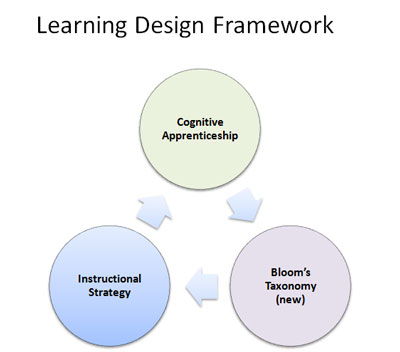
This Learning or Instructional Design Framework is built on three models:
- Collins, Brown, and Newman's Cognitive Apprenticeship
- Bloom's Taxonomy
- Instructional strategies for presenting content as described by van Merriënboer
Cognitive Apprenticeship
Cognitive Apprenticeship is defined as “learning-through-guided-experience on cognitive and metacognitive, rather than physical, skills and processes” (Collins, Brown, Newman, 1989, p. 456). It is composed of four main concepts: Methods, Sequencing, Sociology, and Content (or knowledge). Each of the four concepts have several parts within them as shown in this model:
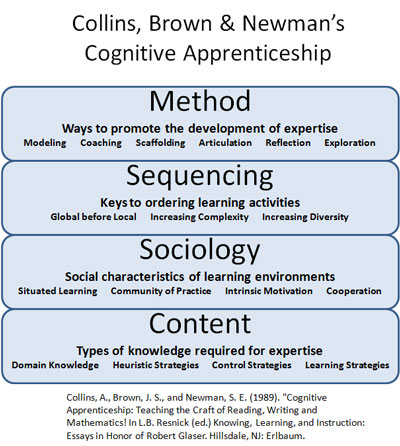
While the authors acknowledge that other forms of learning are important, such as reading or listening, they do not list it in their model (Collins, Brown, Holum, 1991). However, since a greater portion of today's training and learning environments are turning to elearning, which may contain podcasts, slide shows, etc., its important to include them in any instructional design framework. Thus I add these in the “Method” section (shown below) under the title of “2nd or 3rd Person Modeling” as I tend to view such media as being models in the 2nd or 3rd person:

More information about Cognitive Apprenticeship may be found at:
- Cognitive Apprenticeship: Making thinking visible (PDF)
- Navigating the Interactive Workplace (Chief Learning Officer Magazine)
- COGNITIVE APPRENTICESHIP IN EDUCATIONAL PRACTICE: RESEARCH ON SCAFFOLDING, MODELING, MENTORING, AND COACHING AS INSTRUCTIONAL STRATEGIES (PDF)
- In addition, both spreadsheet contains definitions and information about the concepts:
Bloom's Taxonomy
Bloom's Taxonomy (Anderson, Krathwohl, 2001) is a quide for selecting the skill level in which you want the learners to perform. The chart below shows the various activities and are listed from the most complex to the simplest.
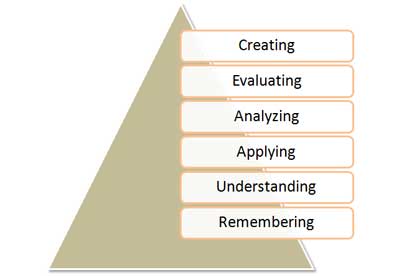
For more information on Bloom's Taxonomy, see Bloom's Taxonomy of Learning Domains: The Three Types of Learning.
Instructional Strategies for Presenting Content
Instructional strategies for presenting content describe four ways of presenting information and examples. Each method has an advantage in a learning environment depending upon what the goals are:
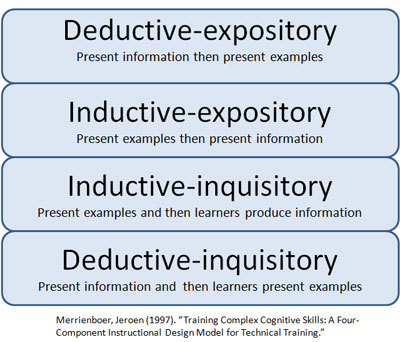
For more information on the four strategies, see, van Merriënboer's 4C/ID Model and Instructional Design. In addition, both spreadsheets contain definitions and information about this concept:
The Framework
The instructional design framework is not a step-by-step process, but more of an idea generator:

However, I do think of it as having some sort of structure:
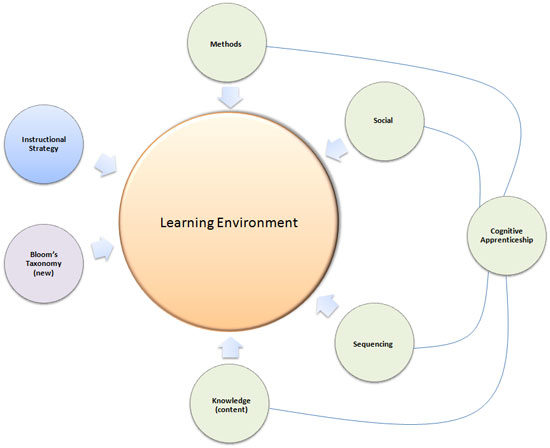
Structure of the Instructional Design Framework Model
The Workbooks
I have two Excel workbooks that I use. The first one uses more of a linear method. You may download it at Linear_Learning_Framework.xls. Although it is more linear in method than the other one, it is good for new instructional designers or complex projects. In addition, it is perhaps the better one to look at first as it is more self-explanatory.

Basically, you list the performance requirements or tasks and then working from left to right, complete the other columns in order to arrive at the basic design.
The second workbook may be downloaded at Learning_Framework.xls. It is a little more dynamic in nature in that it basically represents the “Structure of the Instructional Design Framework” model shown above.

While you can fill in the sections in the middle of the spreadsheet, I generally use it as an idea generator in that I look at it and then use a concept map to document the design. This workbook also has a second framework that you can print out and then pencil in your design (it was requested by a client who thought it might be useful):
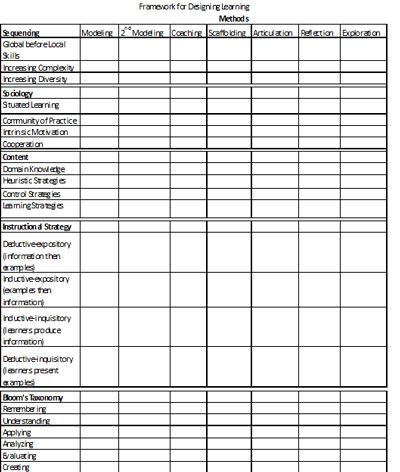
Comments
Let me know what you think of the framework and perhaps what sort of Instructional Design Framework you use in your design and development efforts. You can leave your comments on this blog post.
References
Anderson, L.W., Krathwohl, D.R. (2001). A Taxonomy for Learning, Teaching and Assessing: A revision of Bloom's Taxonomy of educational objectives. New York: Longman.
Collins, A., Brown, J.S., Holum, A. (1991). Cognitive apprenticeship: Making thinking visible. American Educator, 15(3), 6-11, 38-46. (available in PDF format: http://citeseerx.ist.psu.edu/viewdoc/download?doi=10.1.1.124.8616&rep=rep1&type=pdf ).
Collins, A., Brown, J.S., Newman, S.E. (1989). Cognitive Apprenticeship: Teaching the Craft of Reading, Writing and Mathematics. Knowing, Learning, and Instruction: Essays in Honor of Robert Glaser L.B. Resnick (ed.). Hillsdale, NJ: Erlbaum.
Merriënboer, J.J.G. (1997). Training Complex Cognitive Skills: A Four-Component Instructional Design Model for Technical Training. Englewood Cliffs, NJ: Educational Technology Publications.




